Taekwondo History
When you begin to study the history of any martial art, you will find both fact and folklore. When you begin to learn about Taekwondo History, you also learn about the fact and folklore of Korea.
View our easy to ready, Taekwondo History Timeline here.
|
Some researchers believe that cave drawings from around 50 B.C. depict fighters doing martial art poses that look a lot like early forms of Taekwondo. That would make Taekwondo over 2000 years old. However, since people have always been in conflict either with one another or with animals, it is possible that the martial arts go back even before this time. |
 Depictions of men practicing a form of martial art on cave in Korea, projected date 50 B.C. |
As mankind developed weaponry it is reasonable to assume that those who did not have weapons would recognize the need to use their hands, arms, legs, and feet to disarm or disable those who did have weapons. Taekwondo, which focuses mostly on kicks, may have been part of the history of Korean population learning to protect themselves.
Ancient History: Mythology has it that the Tangun (or Dangun) founded the ancient Korean nation in 2333 B.C. There are no records to substantiate that any form of martial arts existed during this time, other than the fact that people had to fight against nature – and other people, of course – to survive.
Three Kingdoms Era: Taekwondo history starts with the establishment of three kingdoms in the Korean peninsula:
|
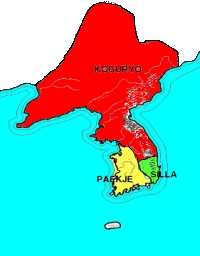 |
The Silla kingdom, initially the smallest of the kingdoms, needed help from Paekje to defend itself against Koguryo the kingdom to the north (as well as against pirates). Paekje had a rudimentary style of martial art, and the soldiers of Paekje taught the soldiers of Silla. Chin Heung, 24th king of Silla, took martial arts training a step further. He required it to be part of the military training and thus began an group of young fighting men named Hwa Rang Do, which translated meant “Flowering Youth.”
These Hwa Rang So soldiers thus learned a early for of Taekwondo called Sabuk; they alsostudied weaponry, such as the sword, spear, and bow. They practiced ethical standards taught by Buddhist monks. The principles of the Hwa rang do required them to be dedicated to more than just themselves; they were honor-bound to serve the kingdom and its citizens and lead a exemplary lifestyle. (These principles paterned the modern-day tenets of Taekwondo taught at most dojangs.) Hwa Rang So military conquests helped to defeat their enemies and eventually unite the three separate kingdoms in the Korean peninsula.
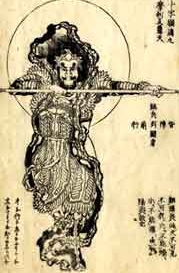 |
At Kyourgi, the ancient capital of Silla, there are pictures of warriors in a military pose similar to the mountain blocks used in the black belt form Kumgang. |
Koryo Dynasty: In 936 A.D., Wang Kon founded the Koryo kingdom.
|
Subak (Su: hand, Bak: fight) was a style of martial arts practiced during the Koryo dyanasty practices by the Hwa Rang Do both for health and for self-defense. During the reign of King Uijong (1147 – 1170) Subak fighters were greatly respected, and Subak was recognized as the national pastime, much as baseball and American football are recognized in the United States today. |
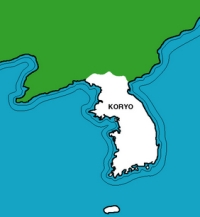 |
Subak was also taught to commoners - not just the Hwa Rang Do and the military - which increased its popularity and number of practitioners.
During the 1300s, the Subak style of martial arts developed into Taekyon (tracing history to the current name of Tae-kwon-do), with an emphasis on kicking. Taekyon became the national sport until the Japanese occupied the country in 1909.
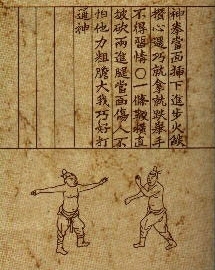 |
With the formation of the Joseon Dynasty (also called the Yi Dynasty), which ruled from 1392 to 1910, the philosophical focus of the military and the elite changed from Buddhism to Confucianism. The martial arts of Taekyon and Subak were discouraged. As a result, Korean martial arts were practiced by the commoners, but with little emphasis on military training. Subak and Taekyon tournaments all but disappeared during this time. |
Japanese Occupation: (1909 – 1945) When Japan invaded the Korean peninsula, all Korean culture was suppressed. Anything connected to Korean heritage, arts, or practices was illegal. Subak and Taekyon masters went into hiding or traveled to other countries, teaching and influencing modern Taekwondo forms.
Modern Taekwondo History: (1945 to the present): The end of World War II brought freedom for the Korean peninsula, and Koreans were free to practice cultural martial arts again.
In 1945, various newly opened Taekyon and Subak schools in Seoul, South Korea, claimed to practice “true” Korean martial arts. By the 1960s, there were nine different martial arts schools, or kwans. Each school practiced a different style. All were similar to Subak and Taekyon. However, many were influenced by other countries’ martial arts, such as Karate and Kung Fu.
In 1952, South Korean President Syngman Rhee was so impressed by a Taekyon demonstration that he ordered all soldiers in the Korean army to be trained in it. General Choi Hung-hi (at the time a Captain) began standardizing the training, bringing Taekyon and Subak back to their Korean roots and stripping away Karate and Kung Fu influences. He urged that the nine different kwans unite in 1955; the common name of Tae Soo Do was suggested as the name of the newly focused art. Two years later, however, reportedly at General Choi’s suggestion, the name Taekwondo (or Tae Kwon Do), translated as “the way of the foot and hand,” was adopted by most of the kwans.
September, 1961, marked the founding of the Korean Taekwondo Association in an effort to further standardize the kwans. The K.T.A. – the governing body of Taekwondo for the country of Korea, similar to USA Taekwondo for the United States – was headed by General Choi. General Choi dispatched Taekwondo masters throughout the world to represent and teach Taekwondo to other countires. He was also charged with creating an international body of representatives and laying the groundwork for the International Taekwondo Federation, which he wanted to base in South Korea.
In 1972, General Choi disassociated himself with the Korean Taekwondo Association (see below) and moved to Toronto, Canada, where he established the International Taekwondo Federation (ITF).
In 1973, representatives from 19 different countries met in Korea to establish the World Taekwondo Federation (WTF), which then had its first world championship.
More about the different organizations of Taekwondo, click here.
|
ITF History General Choi, head of the Korean Taekwondo Association, was instrumental in developing Taekwondo’s popularity by sending demonstration teams from Korea to many parts of the world. In 1966, he sent a team from South Korea to North Korea on a goodwill tour, although the two countries were considered to be at war. The South Korean government (along with many citizens) was outraged, and General Choi was removed from his position as the president of the K.A.T.. |
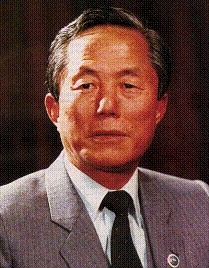 General Choi Hung-hi, Father of Taekwondo |
He moved to Toronto, Canada, and established the International Taekwondo Federation in 1972. The ITF focuses on forms that General Choi created and refined, with the focus on more traditional Taekwondo.
Currently, over 130 countries have dojangs (schools) affiliated with the ITF.
|
ATA History The American Taekwondo Association was established by Haeng Un Lee (posthumously titled “Eternal Grand Master”), who met with General Choi in 1968 to learn the forms that he had developed. |
 |
In 1969, Master Lee founded the American Taekwondo Association, which, according to its web site, currently boasts a membership of over 350,000 practitioners. The current headquarters for the ATA is in Little Rock, Arkansas.
The ATA practices the Songahm Taekwondo style (meaning “Pine Tree and Rock”). The student is the pine tree which grows from a small sapling to a very tall, majestic tree, firm as a rock.
According to the web site, the ATA is a business-model organization, requiring very strict standards for their schools. Generally, a master instructor must adhere to this business model, just as a franchisee of a restaurant chain would.
The ATA holds closed tournaments and holds the copyright to their forms, meaning that one must be a member of the ATA to participate in a ATA tournament or use ATA forms.
The ATA has established a “Grand Master,” certified as a 9th degree black belt, to be the organizational leader (similar to a CEO of a business), and also has a decision-making council (similar to a board of directors for a business).
|
WTF and Olympic History Since 1973, schools in over 160 countries have affiliated with the World Taekwondo Federation. This nationally sanctioned governmental body has its headquartered in Kukkiwon, Seoul, Korea. |
 |
According to their web site, over five million practitioners hold black belt certificate rankings from Kukkiwon.
The International Olympic Committee (IOC) recognized the WTF as the official governing body of Taekwondo in 1980. Taekwondo debuted as a demonstration sport in the 1988 Olympics, and was demonstrated again in 1992. In the 2000 Sydney Olympics, Taekwondo was recognized as an official sport. Compared to the ITF, the WTF practices a more sportlike style of Taekwondo; however, most master instructors [ML8] state that traditional Taekwondo is a part of their training program as well.
The World Taekwondo Federation promotes and sanctions local, regional, national, and international tournaments throughout the world, both for sparring (fighting) and forms. The WTF encourages the popularity of Taekwondo by allowing dojangs (schools) to market themselves to their local communities, teaching the martial art for physical health and fitness and bringing in ethical standards such as were practiced by the Hwa rang do.
WTF and the United States Taekwondo: Masters first came from Korea to the United States to teach Taekwondo for the K.T.A in the early 1960s. A well-received Taekwondo demonstration in 1963 led to the establishment of the US Taekwondo Federation, which was superseded by the Amateur Athletic Union and then the US Taekwondo Union.
The US Taekwondo Union was recognized as the governing body in the United States for WTF-style competition in 1984. In 2004, due to internal problems, the United States Olympic Committee took over the governance of Taekwondo, changing the body’s name to USA Taekwondo in 2005.
We hope this brief overview helps you tie ancient Korean history with modern practices, appreciating the complexity of one of the most popular of martial arts and sports.
Taekwondo Instructors and Schools: Link your school website to Taekwondo-guide.com as a resource for your students.